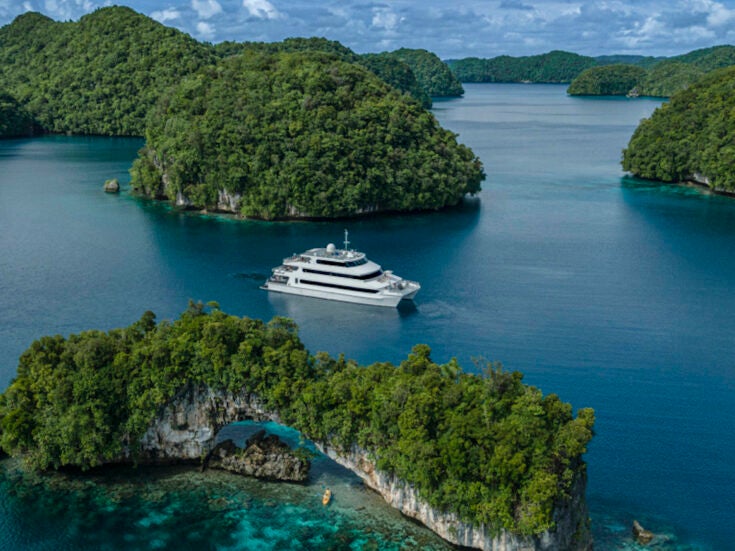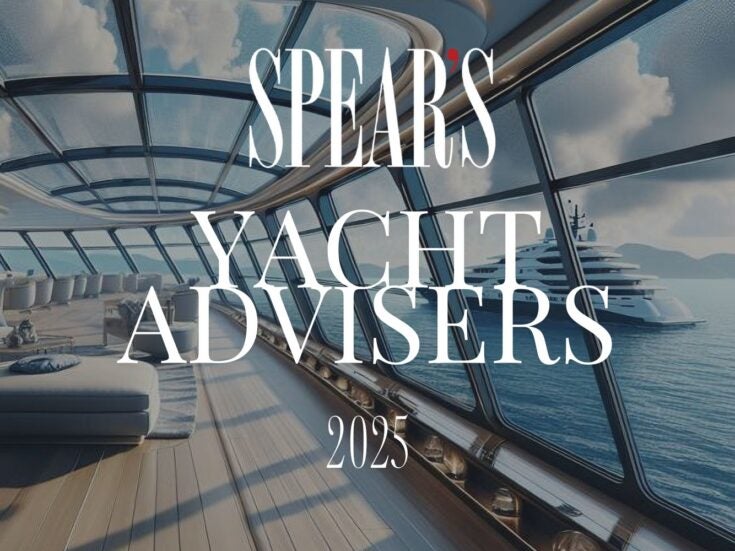
The superyacht industry has been buffeted by headwinds in recent times. In July a major fire at a German shipyard had insurers bracing themselves for more than €200 million in losses; later in the same month a collision between two huge vessels owned by Steve Jobs’ widow Laurene Powell Jobs and Mexican billionaire Ricardo Salinas Pliego generated further unfortunate headlines. Then, in August, the tragic sinking of the Bayesian raised questions about safety that still cast a long shadow.
[See also: Best yacht advisers 2024]
What’s more, in the wake of a pandemic-inspired rush, the market for new and pre-owned superyachts has cooled. According to analysts at Berenberg, this is ‘linked to the perception that yachting is significantly exposed to Russian clientele’.
But the Monaco Yacht Show – the global superyacht industry’s marquee gathering of the year – thrummed with activity last week, attracting 120 superyachts worth a combined €4.6 billion, as well as visitors from the worlds of finance, real estate and luxury watches who came to mingle and clink champagne flutes around Port Hercule. Prices for chartering the most eye-catching boats at the show remained reassuringly expensive: the brand new 122m Kismet, owned by billionaire Jacksonville Jaguars and Fulham FC backer Shahid Khan, was advertised for charter at £3 million per week – a fee that would not include fuel, supplies, tax or tips for the crew.

One of the hottest topics of the sustainability-themed show was the launch of the first ever superyacht to make use of hydrogen fuel cell technology. Widely reported to have been commissioned by Microsoft founder Bill Gates, the 119m craft from Dutch shipbuilder Feadship is known as Project 821 and is for sale with British yacht broker Edmiston for €675 m euros (£579 m). However, it was not exhibited at the show, instead remaining in a shipyard in Holland as its final touches are applied.
[See also: Superyacht broker Jamie Edmiston on empire-building and a greener future]
‘It is the greenest yacht ever built,’ said Edmiston CEO, Jamie Edmiston, who has been involved with the project from ‘the very start’, representing the client in their dealings with the shipyard. But Edmiston would not confirm the identity of the current owner, nor their reasons for placing the vessel on the market before taking delivery of it. In addition to the groundbreaking hydrogen fuel cells, the craft boasts ‘incredible technology to scrub the carbon out of the diesel’ and ‘there’s zero plastic on board,’ said Edmiston. ‘It’s an outstanding achievement.’
However, some were cooler on the idea that hydrogen could be the future of sustainable superyachts. The fuel may be incredibly clean (water is its only exhaust), but the tiny size of hydrogen molecules means that it can leak when being transported and must be kept below -253°C in a double-walled cryogenic storage tank when onboard a yacht. Overall, it takes eight to ten times more space to store hydrogen on a superyacht than it does to store the amount of diesel that would deliver an equivalent amount of energy. While the vast 119m Project 821 has been engineered with this in mind, there are doubts as to whether it will prove to be a practical solution for smaller vessels – even many of those that still comfortably qualify as ‘superyachts’.
‘Hydrogen is very flammable,’ said Niels Vaessen, CEO of Dutch shipbuilder Heesen, which specialises in vessels in the 50m-80m range. ‘Where can you get hydrogen – in which harbour?’ Vaessen added that methanol, which is increasingly being used in commercial shipping by Maersk, was more likely to ‘be the future’.
[See also: Monaco goes for green]

In May Italian shipbuilder San Lorenzo launched Almax, the first superyacht with ‘green methanol’ fuel cell technology. The vessel is able to generate up to 100kW of electricity from biomethanol, which the manufacturer says allows the yacht to sit at anchor without producing any carbon emissions at all.
Heesen is also incorporating the technology into new designs, including its Project Monte Carlo concept, which was unveiled at the show. However, Vaessen noted that to achieve the same range as a traditional diesel-powered craft, a methanol-powered vessel would need a fuel tank more than twice the size. As a result, Heesen is attempting to future-proof its newly built boats by allocating sufficient space for larger fuel tanks. Every yacht the company produces can be built with a hybrid propulsion system, although some clients still choose traditional diesel systems.
[See also: This residential superyacht promises UHNWs high luxury on the high seas]
One greener alternative to diesel is already widely available. Hydrogenated vegetable oil (HVO), the marine equivalent of sustainable aviation fuel (SAF), is sometimes known as ‘renewable diesel’ and is said to reduce greenhouse gas emissions by 40-90 per cent (compared to fossil diesel). It can be used in existing diesel engines without any adaptations or conversions. (In addition to its hydrogen fuel cells Project 821 has generators that burn HVO. Both power sources feed a single grid, which is used to power the engines as well as what is described as the ‘hotel load’, which includes lighting and air-conditioning.)
HVO may cost 10 to 30 per cent more than diesel, but certain eco-minded owners and charterers have not been deterred. ‘When Mrs [Laurene Powell] Jobs takes Venus to the South Pacific – I kid you not – she says: “I don’t want to put diesel in because we never use diesel anymore”,’ said Henk de Vries, co-CEO of Feadship, the company that was commissioned to build Venus by Ms Jobs’ late husband, Steve Jobs. De Vries explained that Ms Jobs stayed true to her principles even if Venus was hundreds of miles away from the closest port with a supply of HVO. She would ask the ship’s captain to arrange a tanker – that would itself be fuelled with HVO – to deliver HVO to refuel Venus. ‘It’s only money,’ said de Vries. ‘In the end, the footprint of getting [HVO] there and burning it is a lot better than buying local diesel.’ (A spokesperson for Laurene Powell Jobs declined a request to comment.)

Away from fuel and propulsion systems for new yachts, refitting companies used the Monaco Yacht Show as an opportunity to publicise measures to make existing craft more sustainable. ‘Several [new] energy efficient yachts are on display at the show,’ said Jean-Marc Bolinger, CEO of refitter MB92 Group. ‘On the other hand, there is a fleet of 6,000 yachts which need to start the sustainability journey.’ (There are a total of 5,932 superyachts – vessels over 30m in length – on the world’s oceans, according to research by SuperYacht Times.)
[See also: Best aviation and yacht finance advisers in 2024]
Increased use of mains power while in port, solar panels, more efficient lighting and weight reduction were among measures that could make existing craft more sustainable, said Bolinger. There were also more left-field suggestions, such as avoiding the use of teak, which has traditionally been the material of choice for ships’ decking but has become more difficult to source responsibly. Myanmar, which had been among the leading exporters of the wood, has been subject to US and EU sanctions following a 2021 military coup that overthrew the democratic civilian government.
Indeed, attendees of the show were implored to avoid ‘carbon tunnel-vision’. In a presentation on sustainability, nitrogen emissions, particulates and damage to ecosystems were among 12 potential harms listed in addition to carbon emissions by Robert Van Tol, executive director of the Water Revolution Foundation.
But there was also optimism about the industry’s appetite for change. Van Tol said that when he and his colleagues first began to discuss sustainability six years ago, the topic ‘was not very convenient’ for the industry, but that it had now ‘arrived in the common narrative’. ‘So that has been great progress… we need everyone at this show and in this industry to move forward.’ He added that charter clients had become more interested in environmental impact and were increasingly comparing boats on that basis.

Despite the challenges it faces, the superyacht industry has become a magnet for a wide range of businesses that deal with UHNW clients. In the words of Josh Evans, chief officer aboard the 86m HBC (pictured below), ‘Everything to do with money comes here for this week.’ The title sponsor of the show was the luxury watch marque Richard Mille, which staged a number of events and dinners, including one that was hosted in partnership with investment advisory firm Azura Partners. Dubai-based property developer Omniyat also chose the Monaco Yacht Show to launch The Alba, a $1.9 billion project designed by Zaha Hadid Architects that will combine ‘ultra-luxury residences’ and a beachfront hotel on the Eastern Crescent of Dubai’s Palm Jumeirah.

By the end of the show, no one had yet stepped forward to meet the €675 million asking price for Project 821. Selling a yacht that remained in a shipyard in Holland rather than being displayed at the show might usually be a little trickier, admitted broker Edmiston. But he is not concerned. ‘This is the best yacht ever built,’ he said. ‘I think that boat will sell very soon.’
The Monaco Yacht Show will return 24-27 September 2025.






